Green Dynamic Kinetic Resolution—Stereoselective Acylation of Secondary Alcohols by Enzyme-Assisted Ruthenium Complexes
Abstract
:1. Introduction
2. Results and Discussion
2.1. Racemization Studies
2.2. DKR Studies
3. Materials and Methods
3.1. Synthesis of [Ru(1)]
3.2. Synthesis of [Ru(2)]
3.3. Synthesis of IL
3.4. Immobilization of IL on MWCNT
3.5. General Procedure for Immobilization of Ruthenium Complex 1 on Carbon Nanotubes
3.6. General Synthesis with Dynamic Kinetic Resolution
3.7. General Procedure for the DKR Recycle Test
4. Conclusions
Supplementary Materials
Author Contributions
Funding
Data Availability Statement
Conflicts of Interest
References
- Choi, J.H.; Choi, Y.K.; Kim, Y.H.; Park, E.S.; Kim, E.J.; Kim, M.J.; Park, J. Aminocyclopentadienyl Ruthenium Complexes as Racemization Catalysts for Dynamic Kinetic Resolution of Secondary Alcohols at Ambient Temperature. J. Org. Chem. 2004, 69, 1972–1977. [Google Scholar] [CrossRef]
- Karvembu, R.; Prabhakaran, R.; Muthu Tamizh, M.; Natarajan, K. Ruthenium and Enzyme-Catalyzed Dynamic Kinetic Resolution of Alcohols. Comptes Rendus. Chim. 2009, 12, 951–962. [Google Scholar] [CrossRef]
- Fernández-Salas, J.A.; Manzini, S.; Nolan, S.P. A Cationic Ruthenium Complex for the Dynamic Kinetic Resolution of Secondary Alcohols. Chem. Eur. J. 2014, 20, 13132–13135. [Google Scholar] [CrossRef]
- Huerta, F.F.; Minidis, A.B.E.; Bäckvall, J.E. Racemisation in Asymmetric Synthesis. Dynamic Kinetic Resolution and Related Processes in Enzyme and Metal Catalysis. Chem. Soc. Rev. 2001, 30, 321–331. [Google Scholar] [CrossRef]
- Pellissier, H. Recent Developments in Dynamic Kinetic Resolution. Tetrahedron 2008, 64, 1563–1601. [Google Scholar] [CrossRef]
- Eckert, M.; Brethon, A.; Li, Y.X.; Sheldon, R.A.; Arends, I.W.C.E. Study of the Efficiency of Amino-Functionalized Ruthenium and Ruthenacycle Complexes as Racemization Catalysts in the Dynamic Kinetic Resolution of 1-Phenylethanol. Adv. Synth. Catal. 2007, 349, 2603–2609. [Google Scholar] [CrossRef]
- Martín-Matute, B.; Bäckvall, J.E. Dynamic Kinetic Resolution Catalyzed by Enzymes and Metals. Curr. Opin. Chem. Biol. 2007, 11, 226–232. [Google Scholar] [CrossRef] [PubMed]
- Hegedus, L.S.; Söderberg, B.C.G. Transition Metals in the Synthesis of Complex Organic Molecules, 3rd ed.; University Science Books: Sausalito, CA, USA, 2009; ISBN 978-1-891389-59-7. [Google Scholar]
- Mavrynsky, D.; Päiviö, M.; Lundell, K.; Sillanpää, R.; Kanerva, L.T.; Leino, R. Dicarbonylchloro(Pentabenzylcyclopentadienyl)Rutheniuni as Racemization Catalyst in the Dynamic Kinetic Resolution of Secondary Alcohols. Eur. J. Org. Chem. 2009, 2009, 1317–1320. [Google Scholar] [CrossRef]
- Gustafson, K.P.J.; Guðmundsson, A.; Bajnóczi, É.G.; Yuan, N.; Zou, X.; Persson, I.; Bäckvall, J.E. In Situ Structural Determination of a Homogeneous Ruthenium Racemization Catalyst and Its Activated Intermediates Using X-Ray Absorption Spectroscopy. Chem. Eur. J. 2020, 26, 3411–3419. [Google Scholar] [CrossRef]
- Pàmies, O.; Bäckvall, J.E. Combination of Enzymes and Metal Catalysts. A Powerful Approach in Asymmetric Catalysis. Chem. Rev. 2003, 103, 3247–3261. [Google Scholar] [CrossRef]
- Martín-Matute, B.; Edin, M.; Bogár, K.; Bäckvall, J.-E. Highly Compatible Metal and Enzyme Catalysts for Efficient Dynamic Kinetic Resolution of Alcohols at Ambient Temperature. Angew. Chem. Int. Ed. Engl. 2004, 116, 6697–6701. [Google Scholar] [CrossRef]
- Wuyts, S.; de Vos, D.E.; Verpoort, F.; Depla, D.; de Gryse, R.; Jacobs, P.A. A Heterogeneous Ru-Hydroxyapatite Catalyst for Mild Racemization of Alcohols. J. Catal. 2003, 219, 417–424. [Google Scholar] [CrossRef]
- Maurya, M.R.; Kumar, A.; Costa Pessoa, J. Vanadium Complexes Immobilized on Solid Supports and Their Use as Catalysts for Oxidation and Functionalization of Alkanes and Alkenes. Coord. Chem. Rev. 2011, 255, 2315–2344. [Google Scholar] [CrossRef]
- Climent, M.J.; Corma, A.; Iborra, S. Heterogeneous Catalysts for the One-Pot Synthesis of Chemicals and Fine Chemicals. Chem. Rev. 2011, 111, 1072–1133. [Google Scholar] [CrossRef] [PubMed]
- Cao, H.; Zhu, X.H.; Wang, D.; Sun, Z.; Deng, Y.; Hou, X.F.; Zhao, D. Selectivity Enhancement in Dynamic Kinetic Resolution of Secondary Alcohols through Adjusting the Micro-Environment of Metal Complex Confined in Nanochannels: A Promising Strategy for Tandem Reactions. ACS Catal. 2015, 5, 27–33. [Google Scholar] [CrossRef]
- Corma, A.; García, H.; Llabrés, I.; Xamena, F.X. Engineering Metal Organic Frameworks for Heterogeneous Catalysis. Chem. Rev. 2010, 110, 4606–4655. [Google Scholar] [CrossRef]
- Zhao, H. Protein Stabilization and Enzyme Activation in Ionic Liquids. Specific Ion Effects. J. Chem. Technol. Biotechnol. 2016, 91, 25–50. [Google Scholar] [CrossRef] [Green Version]
- Itoh, T. Ionic Liquids as Tool to Improve Enzymatic Organic Synthesis. Chem. Rev. 2017, 117, 10567–10607. [Google Scholar] [CrossRef]
- Wolny, A.; Chrobok, A. Ionic Liquids for Development of Heterogeneous Catalysts Based on Nanomaterials for Biocatalysis. Nanomaterials 2021, 11, 2030. [Google Scholar] [CrossRef]
- Heba, M.; Stradomska, D.; Szymańska, K.; Jarzębski, A.; Ambroziak, K.; Masternak, M.; Kolanowska, A.; Pudło, W.; Kuźnik, N. Engineering and Performance of Ruthenium Complexes Immobilized on Mesoporous Siliceous Materials as Racemization Catalysts. Catalysts 2021, 11, 316. [Google Scholar] [CrossRef]
- Graf, D.D.; Day, N.C.; Mann, K.R. Synthesis and Characterization of Cyclopentadienyl and Pentamethylcyclopentadienyl Ruthenium Complexes of Oligothiophenes. Inorg. Chem. 1995, 34, 1562–1575. [Google Scholar] [CrossRef]
- Stradomska, D.; Heba, M.; Czernek, A.; Kuźnik, N.; Gillner, D.; Maresz, K.; Pudło, W.; Jarzębski, A.; Szymańska, K. Lipase Immobilized on Mcfs as Biocatalysts for Kinetic and Dynamic Kinetic Resolution of Sec-Alcohols. Catalysts 2021, 11, 518. [Google Scholar] [CrossRef]
- Lozano, P.; de Diego, T.; Gmouh, S.; Vaultier, M.; Iborra, J.L. Dynamic Structure-Function Relationships in Enzyme Stabilization by Ionic Liquids. Biocatal. Biotransform. 2005, 23, 169–176. [Google Scholar] [CrossRef]
- Fukushima, T.; Aida, T. Ionic Liquids for Soft Functional Materials with Carbon Nanotubes. Chem. Eur. J. 2007, 13, 5048–5058. [Google Scholar] [CrossRef] [PubMed]
- Khan, Y.; Iqbal, S.; Shah, M.; Maalik, A.; Hussain, R.; Khan, S.; Khan, I.; Pashameah, R.A.; Alzahrani, E.; Farouk, A.-E.; et al. New Quinoline-Based Triazole Hybrid Analogs as Effective Inhibitors of α-Amylase and α-Glucosidase: Preparation, in Vitro Evaluation, and Molecular Docking along with in Silico Studies. Front. Chem. 2022, 10, 995820. [Google Scholar] [CrossRef] [PubMed]
- Kim, M.J.; Hyun, M.K.; Kim, D.; Ahn, Y.; Park, J. Dynamic Kinetic Resolution of Secondary Alcohols by Enzyme-Metal Combinations in Ionic Liquid. Green Chem. 2004, 6, 471–474. [Google Scholar] [CrossRef] [Green Version]
- van Rantwijk, F.; Sheldon, R.A. Biocatalysis in Ionic Liquids. Chem. Rev. 2007, 107, 2757–2785. [Google Scholar] [CrossRef] [PubMed]
- Verho, O.; Bäckvall, J.E. Chemoenzymatic Dynamic Kinetic Resolution: A Powerful Tool for the Preparation of Enantiomerically Pure Alcohols and Amines. J. Am. Chem. Soc. 2015, 137, 3996–4009. [Google Scholar] [CrossRef]
- Martín-Matute, B.; Edin, M.; Bogár, K.; Kaynak, F.B.; Bäckvall, J.E. Combined Ruthenium(II) and Lipase Catalysis for Efficient Dynamic Kinetic Resolution of Secondary Alcohols. Insight into the Racemization Mechanism. J. Am. Chem. Soc. 2005, 127, 8817–8825. [Google Scholar] [CrossRef]
- Kim, N.; Ko, S.B.; Min, S.K.; Kim, M.J.; Park, J. Air-Stable Racemization Catalyst for Dynamic Kinetic Resolution of Secondary Alcohols at Room Temperature. Org. Lett. 2005, 7, 4523–4526. [Google Scholar] [CrossRef]
- Huddleston, J.G.; Visser, A.E.; Reichert, W.M.; Willauer, H.D.; Broker, G.A.; Rogers, R.D. Characterization and Comparison of Hydrophilic and Hydrophobic Room Temperature Ionic Liquids Incorporating the Imidazolium Cation. Green Chem. 2001, 3, 156–164. [Google Scholar] [CrossRef]
- Szelwicka, A.; Wolny, A.; Grymel, M.; Jurczyk, S.; Boncel, S.; Chrobok, A. Chemo-Enzymatic Baeyer–Villiger Oxidation Facilitated with Lipases Immobilized in the Supported Ionic Liquid Phase. Materials 2021, 14, 3443. [Google Scholar] [CrossRef] [PubMed]
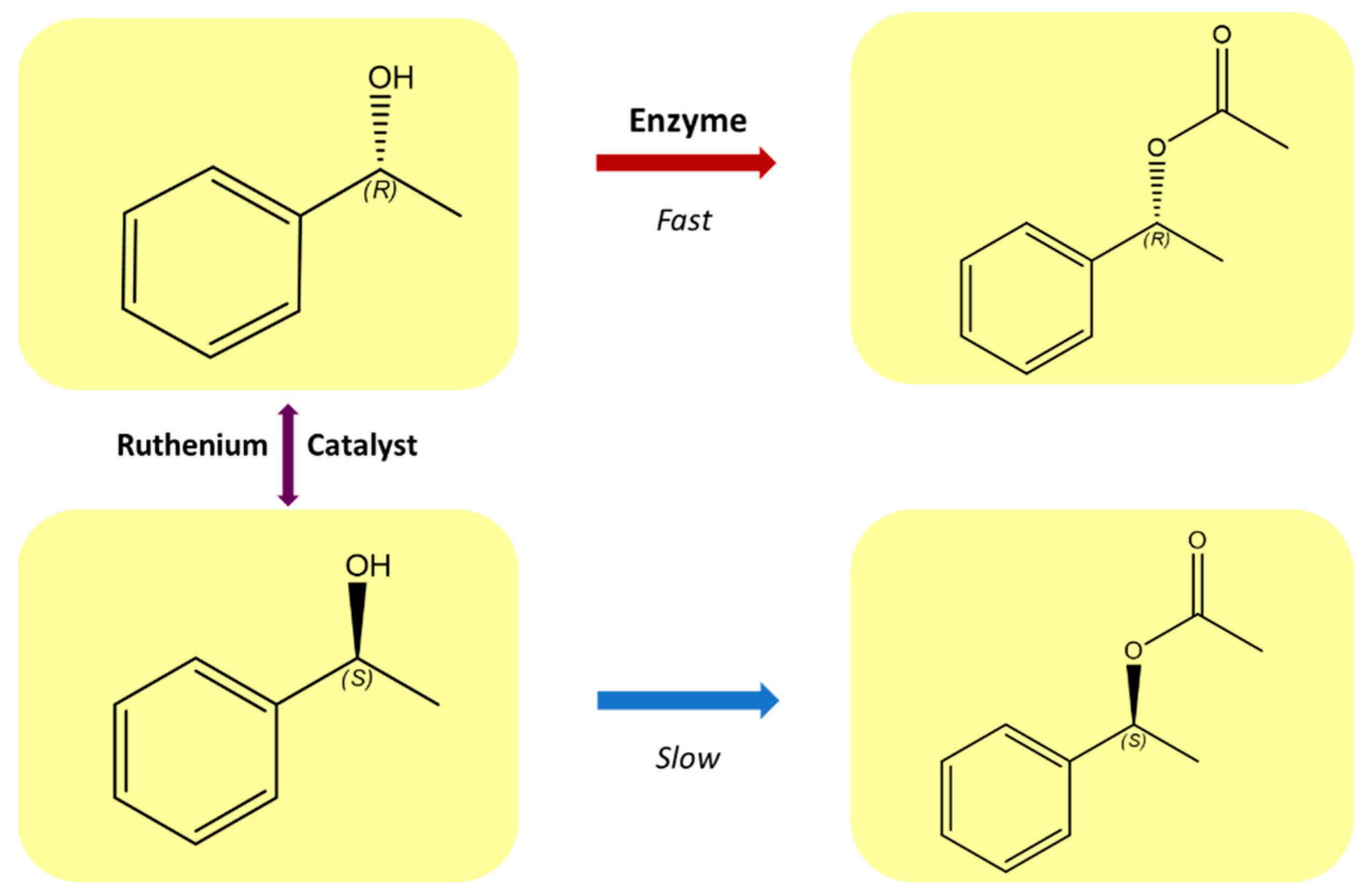


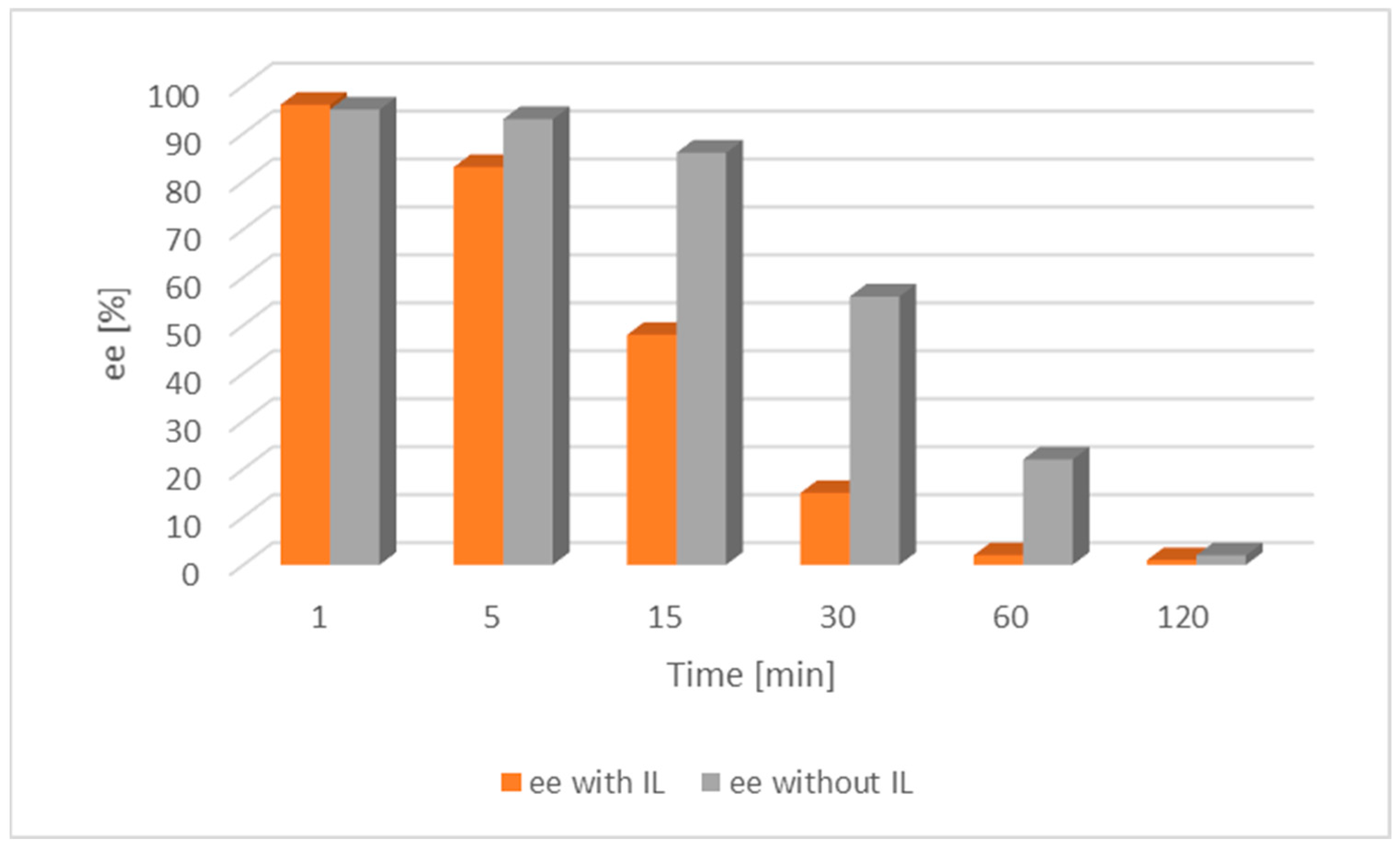
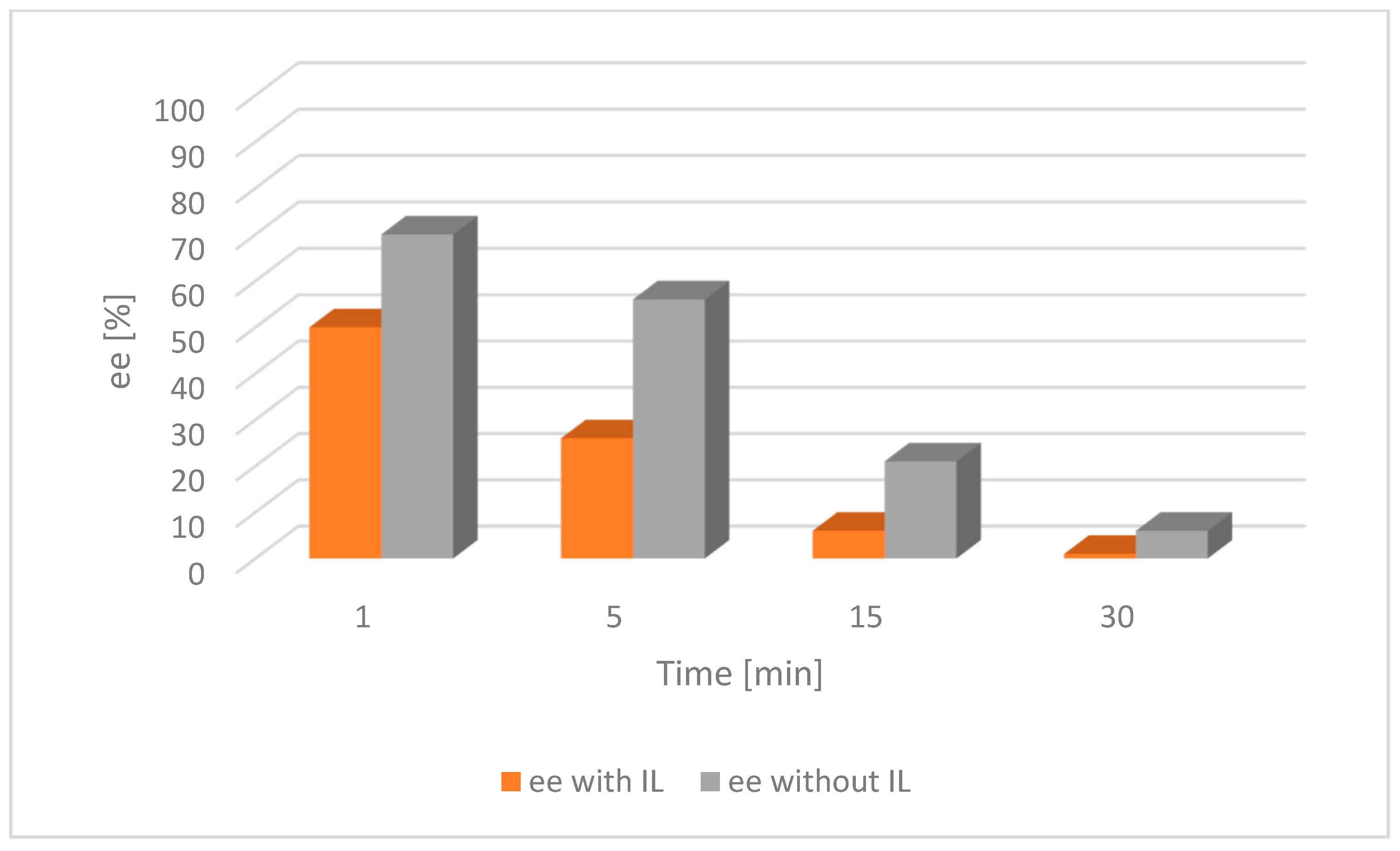
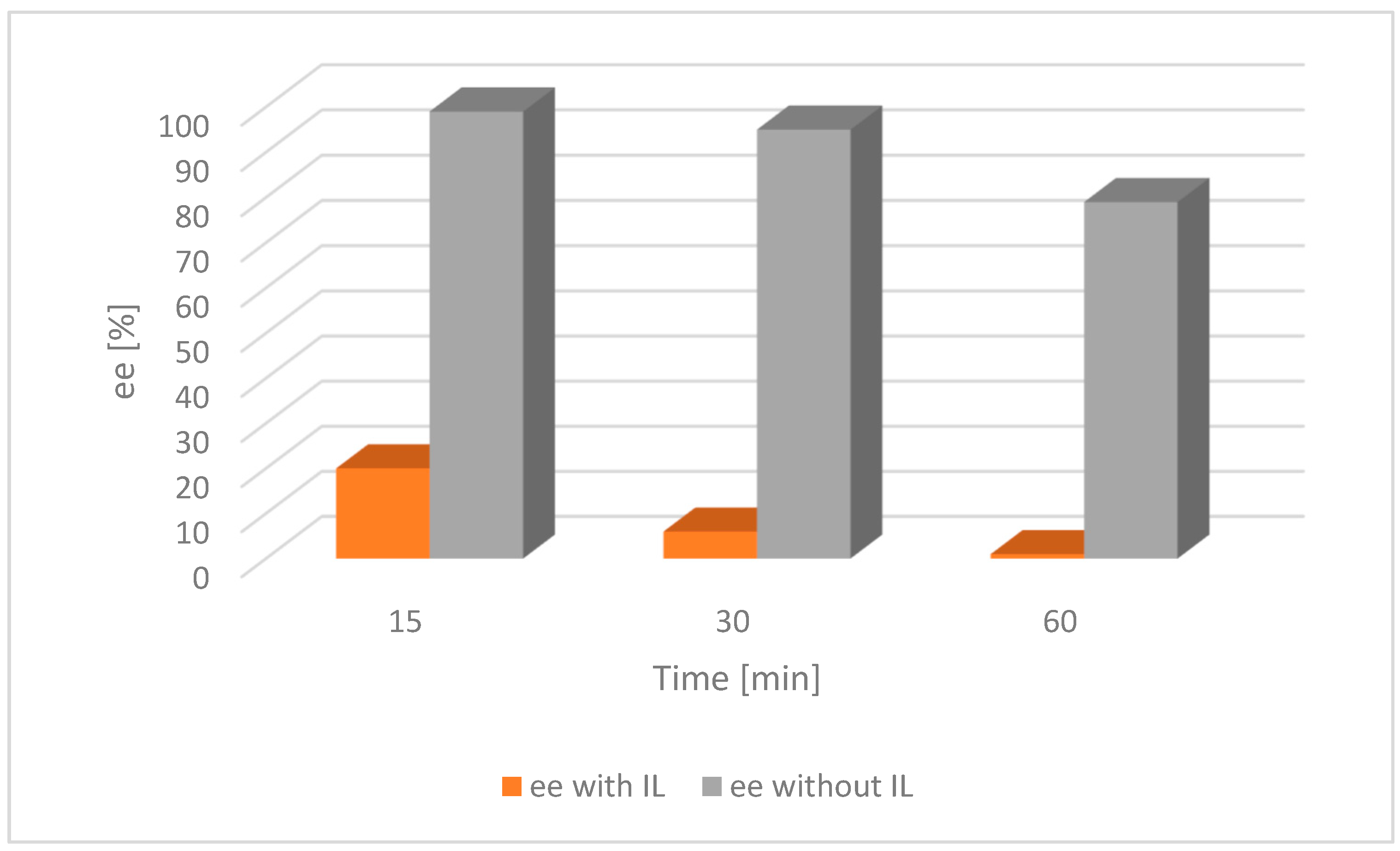

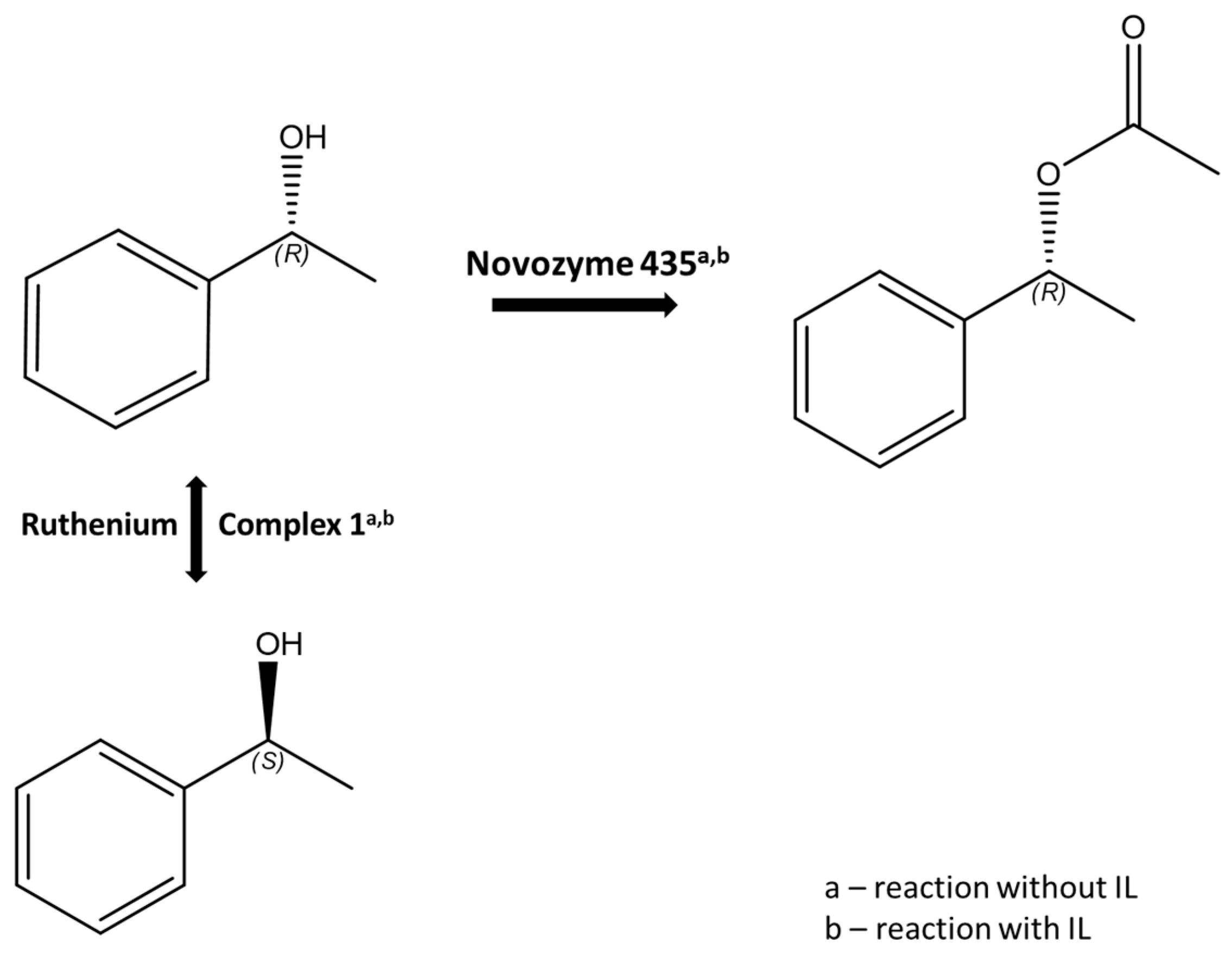
| Racemization Test | Alcohol | Time [h] | ee [%] |
|---|---|---|---|
| [Ru(1)] | 1 | 2 | <1 |
| 24 | <1 | ||
| [Ru(1)] in the presence of MWCNT | 1 | 2 | <1 |
| 24 | <1 | ||
| MWCNT (blank) | 1 | 2 | >99 |
| 24 | >99 | ||
| IL (blank) | 1 | 2 | >99 |
| 24 | >99 | ||
| [Ru(1)-MWCNT] | 1 | 2 | 35 |
| 24 | 2 | ||
| 2 | 2 | 54 | |
| 24 | 25 | ||
| [Ru(1)-IL-MWCNT] | 1 | 2 | 6 |
| 24 | 3 | ||
| 2 | 2 | 62 | |
| 24 | 33 |
| Catalyst | Cycle | ee [%] |
|---|---|---|
| [Ru(1)-IL-MWCNT] | 1 | 10 |
| 2 | 29 | |
| 3 | 76 |
| Entry | Time [h] | Yield % | Ionic Liquid Presence |
|---|---|---|---|
| 1 | 6 | 96 | - |
| 2 | 24 | 99 | - |
| 3 | 6 | 98 | + |
| 4 | 24 | 99 | + |
| Cycle | Yield [%] |
|---|---|
| 1 | 99 |
| 2 | 98 |
| 3 | 84 |
Publisher’s Note: MDPI stays neutral with regard to jurisdictional claims in published maps and institutional affiliations. |
© 2022 by the authors. Licensee MDPI, Basel, Switzerland. This article is an open access article distributed under the terms and conditions of the Creative Commons Attribution (CC BY) license (https://creativecommons.org/licenses/by/4.0/).
Share and Cite
Heba, M.; Wolny, A.; Kastelik-Hryniewiecka, A.; Stradomska, D.; Jurczyk, S.; Chrobok, A.; Kuźnik, N. Green Dynamic Kinetic Resolution—Stereoselective Acylation of Secondary Alcohols by Enzyme-Assisted Ruthenium Complexes. Catalysts 2022, 12, 1395. https://doi.org/10.3390/catal12111395
Heba M, Wolny A, Kastelik-Hryniewiecka A, Stradomska D, Jurczyk S, Chrobok A, Kuźnik N. Green Dynamic Kinetic Resolution—Stereoselective Acylation of Secondary Alcohols by Enzyme-Assisted Ruthenium Complexes. Catalysts. 2022; 12(11):1395. https://doi.org/10.3390/catal12111395
Chicago/Turabian StyleHeba, Monika, Anna Wolny, Anna Kastelik-Hryniewiecka, Dominika Stradomska, Sebastian Jurczyk, Anna Chrobok, and Nikodem Kuźnik. 2022. "Green Dynamic Kinetic Resolution—Stereoselective Acylation of Secondary Alcohols by Enzyme-Assisted Ruthenium Complexes" Catalysts 12, no. 11: 1395. https://doi.org/10.3390/catal12111395
APA StyleHeba, M., Wolny, A., Kastelik-Hryniewiecka, A., Stradomska, D., Jurczyk, S., Chrobok, A., & Kuźnik, N. (2022). Green Dynamic Kinetic Resolution—Stereoselective Acylation of Secondary Alcohols by Enzyme-Assisted Ruthenium Complexes. Catalysts, 12(11), 1395. https://doi.org/10.3390/catal12111395









